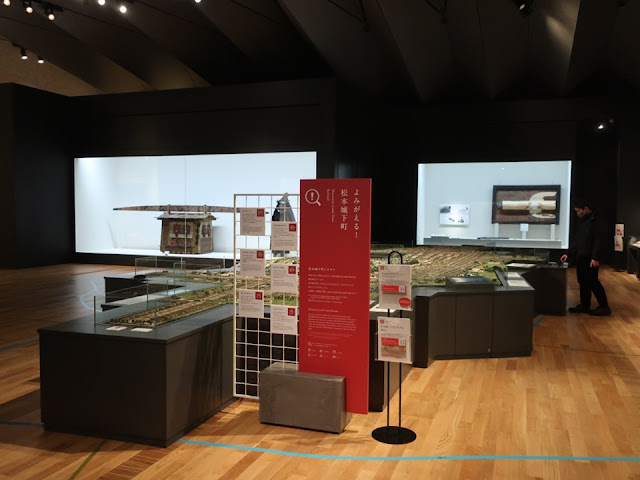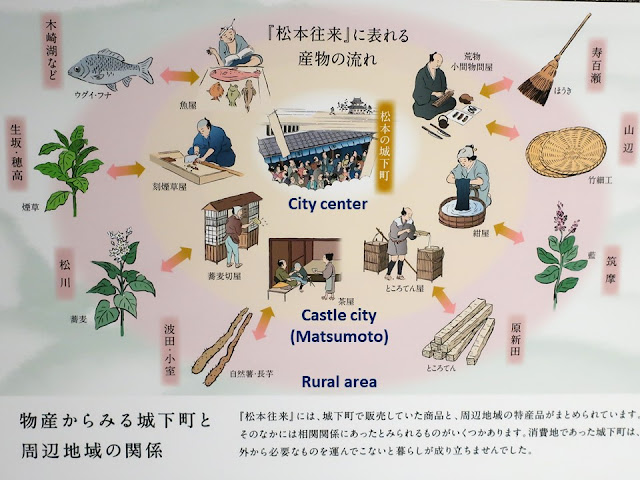Matsumoto city is the second largest one in Nagano prefecture of central Japan. It developed as a castle city. We can understand the wish of Matsumoto people along with its history well. They have enjoyed the prosperity as a castle city & a logistics hub, many hot springs, high mountains and praying to a deity in each residential district. I have stationed at Matsumoto more than a year, so I feel close to exhibits.
Matsumoto City Museum
松本は城下町として大きな発展を遂げ、信州の中核都市になりました。発展の歴史とともに、松本の人々は何を願って生きてきたか、よくわかる展示です。物資が集まる城下町のにぎわい、豊富な温泉の恵み、聳える山や身近な神様・道祖神への願いを通じて暮らしを営み、楽しんできたのだと思います。二拠点居住ですが、松本で暮らして1年が過ぎ、展示内容がとても身近に感じられました。
Entrance of the permanent exhibition room. The titles of eight sections are shown.
常設展示室の入口では、8つのテーマが紹介されています。
1.A Town with a Castle、お城のあるまち
The section occupies half of the exhibition area.
展示室の約半分を占めるコーナーです。
The castle is at the heart of the town; it was surrounded by wooden houses which had stones on their roof. I know the current town, so I am interested in the difference between the old one and the current one. It is a one to three-hundredth scale model. Highways from four directions led to Matsumoto.
お城を中心に石を載せた板葺き屋根の家が並びます。松本に住んでいると、昔と今の違いがよくわかり、ジオラマ(1/300)を楽しめます。街道が東西南北から松本に集まっていました。
Work and Life of Samurai、武士の日常
Based on the official journal, samurai’s everyday life is explained; it is written, “nothing
unusual happened during patrol”, “went to a hot spring resort nearby (Asama
onsen)” and so on.
In 1867, he joined a poetry party,
visited a peony garden; he enjoyed cultural life. But,
it was the year when the shogunate (1603-1867)
was abolished in October. Even after the long peaceful time, samurai also took
peace for granted. Although someone may criticize it, I love a peaceful time
which admits samurai (warrior) to join a poetry party.
業務日誌をもとに、見回りをしたが「別状無」という平和な一日や、浅間温泉に出かけた日が紹介されています。
1867年の日誌には、歌会に参加したり、ぼたんを見に出かけたり、文化も楽しんだ武士として紹介されています。10月14日(旧暦)には大政奉還があった年です。11月3日には、城下町南部でお札が降り、ええじゃないかの大騒ぎとなったと書かれています。1864年には和田峠で水戸から来た天狗党と少し戦い、あっさり通過させてしまった松本藩でした。平和ぼけかもしれませんが、殺し合いをするより良いとおもいます。
Samrai practiced martial arts hard. The votive picture tablet (ema, right) of fire arrows was offered in 1853; samurai celebrated the success of western-style gunnery test and made it. The caption by the book says, “This secret book was written on the breeding and training falcons, and was handed down in the family of a falconer”. Falconry was a kind of martial arts.
武芸に励み、砲術実験の成功を祝して絵馬を奉納した武士たちでした(右)。鷹匠に伝わる鷹狩りの取説(右下)は秘伝でした。
The picture above shows the presents to the lord to celebrate the 100th anniversary. The box at top, which was used to deliver sweets to the lord, is also exhibited.
戸田氏の藩主就任100年を祝い、藩内の村や町から献上された品々です。藩主にお菓子を届けるのに使われた御用箱も展示されています(中央上)。
Products in the region were brought to Matsumoto, were processed and were sold. For example, buckwheat cultivated in a northern village (Matsukawa) were brought to Matsumoto and were processed and sold as soba noodle. It was a compact economic zone which center was the castle town.
周辺地域で作られた産物や製品が町場に持ち込まれ、加工され販売されました。松川で栽培された蕎麦は、松本で蕎麦切りとして売られました。城下中心で、今よりもコンパクトな経済圏ですね。松本藩は幕末で6万石、大藩とはいえませんが、松本盆地の4市7町村(北の小谷村から南の塩尻市まで)が領地でした。
It is written, “You can see that various merchants supported the rich diet of the castle town”. One third of merchants were engaged in the food industry.
松本の職人・商人のうち、1/3が食に関する仕事をしていました。「城下町の豊かな食生活を支えていた」と書かれています。
In the other exhibition room, seven sections are displayed.
もう一つの展示室には、残る7つのテーマについて展示されています。
2.A Bustling Main Road (city center)、にぎわう商都
It is written, “Over a thousand loads, carried on the backs of cows and horses, were coming and going each day.” Matsumoto has been a logistics hub.
The votive picture tablet on the right depicted a transportation by horse, “Chuma”. It says, “Chuma transported goods directly to their destinations without stopping at lodging areas. --- However, this new business was often at odds with existing support services in the lodging areas, where horses stopped and goods were transferred, and often conflict occurred.”
松本には街道が集まり、「牛馬の荷物一日に千駄附け入りて、また千駄附け送るとぞ、実に繁盛の地なり」と書かれています。
右側には、馬方が4頭の馬を引いている中馬の姿を描いた絵馬(複製)があります。交通安全と商売繁盛を願って奉納されました。保福寺にある実物も拝見しました。中馬は発着地を結ぶ直行便。宿場ごとに荷物を引き継いで行く公的な運送を担った人たちとの訴訟合戦などもありました。
After the economic prosperity of the city, the culture flourished. It says, “With financial stability and success, merchants began spending more time and money on cultural activities, such as reading books. The activity around bookstore in the exhibit shows the demand for books and the growing cultural interest of merchants around the time.”
人が集まると商売をする人が増え、町がにぎわいます。教養や文化の活動も増え、書物の需要も増えました。書店の実物模型が展示され、「書店のにぎわいは、商人たちの文化的な成熟がみてとれる一場面です」と書かれています。
The tour guidebook “Landmarks on Zenkoji Temple Road (1849)” shows ame-ichi (or literally, candy festival) in Matsumoto. Not only many people rushed but also many banners were offered by Tokyo and Nagoya merchants.
当時売られていた書物の中に、「善光寺道名所図会」(1849)が展示されていました。観光ガイドブックです。松本の「あめ市」のページが開かれています。大変な人出とともに、江戸や尾張の商人からも幟が奉納されています。
“Ame-ichi” has more than 400-year history. People welcome the deity (Ichi gami) to the city center, pray for business prosperity, and bought sacred salt. Many candy stands opened at the event, so it is called “Ame-ichi (candy market)” now.
「あめ市」は400年以上続く行事です。1年の最初の市に市神様をお迎えして、商売繁盛を願い、拝殿で浄塩を買いました。多くの飴屋が屋台を出すようになり、今では、あめ市とよばれています。
Divine salt (left) and amulets which were sold in 1992 are displayed. It is written, “if you put the salt in rice porridge on January 15th, you will be spared from bad luck” and so on.
あめ市で販売される塩とお札です。何れも1992年のものです。塩は、「1月15日のおかゆに入れて食べると厄を免れる」などと言われています。
Treasure ship is also displayed at ame-ichi.
あめ市の宝船も飾られます。
Children have sold lucky charms, which is considered to learn business skills. I didn’t know it.
子どもは縁起物を売っているのですね。来年は、よく観察しようっと。
Ame-ichi faced difficulty continuing because of lack of practitioners. However, it is a popular event even now. (14th of January, 2024)
あめ市は、担い手不足で存続の危機に陥ったこともあったそうですが、今もにぎわっています(2024年1月14日、中町通りにて)。
Self-deprecating comments are written in the panels at the center of seats of the lounge above. Matsumoto is the second largest city of the prefecture, so its people tend to envy the prefectural capital (Nagano city) but have pride of their city.
休憩スペースの3つのベンチの中心には、
「長野県ではなく信州です 100年続く長野市への一方的なライバル意識と松本プライド」「空港はあるけど新幹線は北をリニアは南を通り過ぎていきます どうなる松本どうする松本」「論多くしてまとまらない様子から『松本のすずめ』と言われる松本人 おっしゃる通りです」
と書かれた自虐的なパネルがはめ込まれています。英語訳は付いていません。今の松本の微妙の立ち位置が分かります。
Visited in March, 2024
Official website: https://matsumoto-city-museum.jp/ (in
Japanese. Automatic translation is attached), accessed in June, 2024
Previous post (museum in a castle town in Fukui prefecture of central Japan): Ichijodani
Asakura Family Site Museum、一乗谷朝倉氏遺跡博物館
Next post (part2 of this article): Matsumoto City Museum (2/2)、松本市立博物館 (part2)




















Comments
Post a Comment